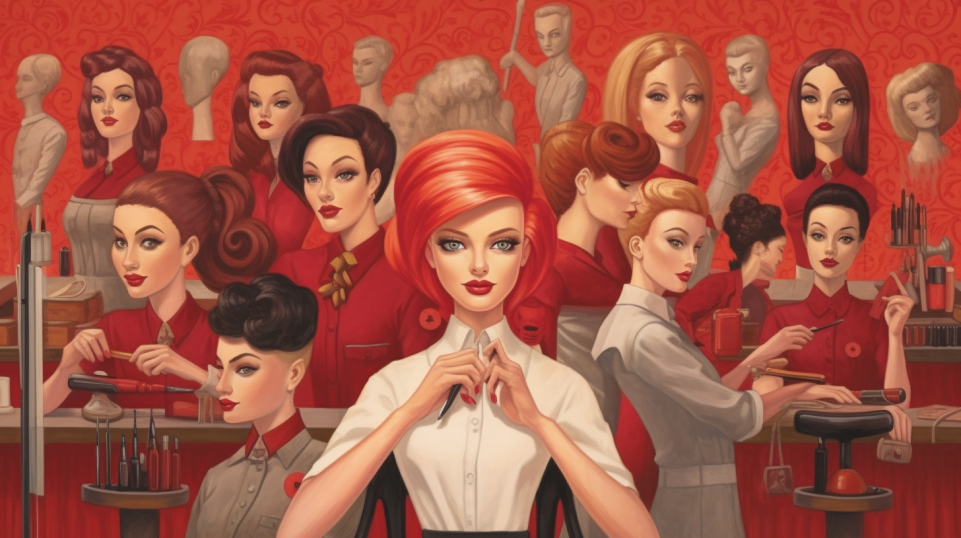Welcome to the fascinating and creative world of hairstyling! This profession, centered on beauty, fashion, and personal care, is an exciting journey filled with opportunities for self-expression and client transformation. If you have a passion for hair, love working with your hands, and find satisfaction in making people feel good about themselves, then a career as a hairstylist may be the perfect path for you.
In this blog post, we will guide you through the journey of becoming a hairstylist. From understanding the role to meeting educational requirements, gaining practical experience, and eventually building your own brand, this guide aims to equip you with the knowledge you need to embark on this rewarding career.
Being a hairstylist is about more than just cutting and styling hair; it’s about understanding individual styles, trends, and most importantly, the people who sit in your chair. Hairstylists are artists, therapists, confidants, and sometimes magicians, transforming their clients’ looks and in turn, their self-confidence. So, if you are excited about embarking on this journey, let’s dive in and explore the steps to becoming a hairstylist!
Understanding the Role of a Hairstylist
Before we delve into how to become a hairstylist, it’s important to fully comprehend what this profession entails.
Day in the Life of a Hairstylist
As a hairstylist, your day could begin early and end late. It’s a job that requires patience, creativity, and excellent communication skills. Throughout the day, you’ll consult with clients about their desired look, offer suggestions based on their hair type and face shape, and ultimately perform the agreed-upon services. This could be anything from haircuts and blowouts to complex color services and special occasion styles. Additionally, you’ll also be responsible for maintaining a clean workspace, managing appointments, and potentially selling hair care products. As you gain experience, you might even take on some salon manager duties like mentoring junior stylists.
Skills and Abilities Required
Being a successful hairstylist demands a unique combination of skills. First and foremost, you’ll need technical proficiency with various tools and techniques, including cutting, coloring, and styling hair. But there are other important skills too:
- Creativity: Keeping up with the latest trends and techniques, and knowing when to apply them.
- Communication: Listening to clients’ desires, explaining what’s possible, and managing expectations.
- Physical Stamina: Standing for extended periods and maintaining focus on detailed tasks.
- Customer Service: Building relationships with clients and making them feel comfortable.
- Salesmanship: Recommending and selling suitable hair care products to clients.
Different Specializations in Hairstyling
Within the field of hairstyling, there are many areas in which you might choose to specialize. For instance, you could become an expert in hair coloring techniques like balayage or ombre, or you could focus on hair extensions or texture services. Specializing in bridal or event hair styling is another potential path. The choice depends on your interest and where your creativity and skill shine the most.
In the next section, we will discuss the educational and training requirements to become a certified hairstylist. Understanding these requirements is crucial as they not only equip you with the skills necessary for the job but also provide the credentials that clients and employers seek.
Educational Requirements and Training
Embarking on a career in hairstyling requires specific training and education. This section outlines the journey from high school education to becoming a licensed professional.
High School Education
To start, a high school diploma or GED is generally required for admission to cosmetology programs. Some high schools may offer vocational training courses in cosmetology, which can be an excellent way for interested students to begin their training early.
Cosmetology School
After completing high school, aspiring hairstylists usually attend a state-licensed cosmetology school where they learn the art and science of hairstyling.
- Explanation of the Curriculum: The curriculum covers a broad range of topics, including hair cutting, coloring, and styling techniques, chemical processes, hygiene and sanitation, and salon software management. Additionally, many programs also include training in other areas of cosmetology, such as skin care and nail care.
- Time Frame for Completion: The length of cosmetology programs varies but typically ranges from nine months to two years, depending on whether you’re attending full-time or part-time.
Licensing Requirements
After completing a cosmetology program, you must pass a state licensing examination to legally work as a hairstylist. The examination usually includes a written component and a practical demonstration of skills. License renewal is typically required every few years and may require proof of continuing education.
While these are the common steps toward becoming a hairstylist, the actual path may vary by state or country due to different regulations. Always make sure to check the specific requirements for the area in which you plan to work.
In the next part, we will explore the importance of gaining practical experience, even while you’re still in school, and how it can boost your career prospects.
Gaining Practical Experience
 Even while meeting educational requirements, practical experience plays a pivotal role in honing your skills as a hairstylist. It helps in building confidence, mastering techniques, and understanding the salon environment better. Here’s how you can gain valuable experience.
Even while meeting educational requirements, practical experience plays a pivotal role in honing your skills as a hairstylist. It helps in building confidence, mastering techniques, and understanding the salon environment better. Here’s how you can gain valuable experience.
Apprenticeship and Its Importance
Many salons offer apprenticeships that allow you to work under the guidance of an experienced hairstylist. This hands-on training can provide invaluable insights into client consultation, advanced techniques, and the realities of salon operations. Some states even allow apprenticeships as a path to licensure.
Part-time Jobs and Volunteering in Salons
Starting out as a salon assistant or receptionist can offer a great initial exposure to the salon environment. Similarly, volunteering to assist at hair shows or local fashion events can provide an opportunity to observe professionals at work, network, and learn about the latest trends and techniques.
Participation in Hair Styling Competitions
Competitions can be an excellent platform for showcasing your skills and creativity. Participation can also open up networking opportunities and the potential to be spotted by industry professionals.
Practical experience not only enhances your skill set but also prepares you for the job market. In the following section, we will guide you on job search and career advancement strategies in the hairstyling industry.
Job Search and Career Advancement
After acquiring the necessary education and experience, it’s time to step into the professional world. Here’s how to make a successful entry and advance your career as a hairstylist.
Building a Professional Portfolio
A portfolio showcases your talent and creativity to potential employers and clients. It should include photographs of your best work, covering a range of styles and techniques. Today, a digital portfolio, such as an Instagram page dedicated to your work, is a great way to reach a wider audience and attract potential employers.
Job Interview Tips for Hairstylists
Job interviews for hairstylists can be unique. In addition to answering questions, you may be asked to demonstrate your skills. Here are some tips:
- Be prepared to perform a haircut, style, or color.
- Show your knowledge about current trends and techniques.
- Discuss your customer service skills and ability to build clientele.
Continuous Learning and Certification
Even after securing a job, continuous learning is crucial for career advancement. Stay updated with new techniques, trends, and products in the industry. Obtaining advanced certifications in areas such as hair color, extensions, or keratin treatments can also help you stand out and potentially earn a higher income.
The next section will guide you on establishing your own brand as a hairstylist, which is an important part of building your clientele and setting yourself apart in this competitive industry.
Building Your Own Brand
As a hairstylist, your personal brand can be a powerful tool for attracting and retaining clients. Here are some key steps to establishing your brand.
Importance of Networking and Building Clientele
Networking is essential for your growth as a hairstylist. Attend industry events, hair shows, and seminars to meet other professionals, learn about trends, and gain exposure. Building a strong clientele base is also important; remember that satisfied clients are likely to return and refer others.
Leveraging Social Media and Online Platforms
In this digital age, your online presence is a significant part of your brand. Platforms like Instagram, Pinterest, and YouTube allow you to showcase your work, share hair care tips, and interact with potential clients. Make sure to post regularly and engage with your audience to build a strong online community.
Opening Your Own Salon: Steps and Considerations
For many hairstylists, opening their own salon is a long-term goal. If this appeals to you, start by gaining experience in salon management and building a solid client base. When you’re ready, create a detailed business plan, secure financing, choose a location, and curate a comfortable and inviting atmosphere for your clients.
In the next section, we’ll discuss the challenges and rewards of being a hairstylist to give you a realistic view of what to expect from this career.
The Challenges and Rewards of Being a Hairstylist
Like any profession, being a hairstylist comes with its own set of challenges and rewards. Understanding these will help you navigate the path more effectively.
Work-life Balance
Working as a hairstylist can mean long hours, especially on weekends and during wedding seasons when demand is high. Managing time effectively, setting boundaries, and ensuring self-care is essential to maintaining a healthy work-life balance.
Job Satisfaction and Growth Opportunities
Despite the challenges, hairstyling can be incredibly rewarding. You’ll have the opportunity to meet new people daily, make them feel good about themselves, and express your creativity. As you gain experience, there are numerous paths for advancement, such as becoming a salon manager, a hairstyling educator, or even owning your own salon.
Stories of Successful Hairstylists for Inspiration
Sharing stories of successful hairstylists can offer valuable insights and inspiration. Whether they’ve opened their own salons, worked with celebrities, or created a popular hair care line, their journeys illustrate the vast opportunities in this field.
As we move towards the conclusion, we will recap the essential steps of becoming a hairstylist and provide a few words of encouragement for aspiring hairstylists.
Conclusion
Embarking on a journey to become a hairstylist can seem overwhelming at first glance, but when you break it down into steps, it becomes more manageable. This comprehensive guide has walked you through understanding the role of a hairstylist, the educational requirements and training, the importance of gaining practical experience, and the process of job search and career advancement.
Becoming a hairstylist is a rewarding career path for those with a passion for beauty and an ability to connect with people. The road to becoming a successful hairstylist requires commitment, patience, creativity, and excellent customer service skills. But remember, the investment in your skills and education will pay off when you start creating beautiful transformations for your clients.
This career allows you to express your creativity while making others feel good about themselves. It offers countless opportunities for lifelong learning and growth, and the possibility of one day owning your own salon. There’s a world of potential waiting for you in the hairstyling industry. So go out there, seize every opportunity, and never stop learning and creating!
Q&A Section
This section addresses some frequently asked questions about becoming a hairstylist. These answers aim to clear any lingering doubts and provide additional information to aspiring hairstylists.
1. How long does it take to become a hairstylist?
The time it takes to become a hairstylist can vary based on your state’s requirements and whether you’re studying full-time or part-time. Typically, a cosmetology program takes between 9 months to 2 years to complete. After graduating, you’ll need to pass your state’s licensing exam to become a certified hairstylist.
2. Can I specialize in certain areas of hairstyling?
Absolutely! Many hairstylists choose to specialize in areas that particularly interest them. These can include hair coloring, hair extensions, curly and textured hair, bridal hairstyling, and more. Specializations can be pursued through additional coursework or on-the-job training.
3. Is it necessary to have a license to work as a hairstylist?
Yes, all states require hairstylists to be licensed. Requirements can vary but typically involve graduating from a state-approved cosmetology program and passing a licensing exam.
4. What is the job outlook for hairstylists?
The job outlook can vary depending on your location. However, the field of personal appearance workers, including hairstylists, is generally expected to grow. As current hairstylists retire and new hair services continue to develop, opportunities for new hairstylists will arise.
5. Can a hairstylist have their own salon?
Yes, many hairstylists aspire to and do become salon owners. This step usually comes after gaining substantial experience in the field, developing a strong client base, and obtaining the necessary business skills.
We encourage you to use the comment section below to ask any further questions or share your experiences on your journey to becoming a hairstylist. We look forward to hearing from you!


